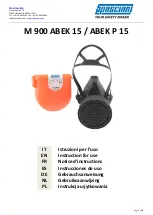
17
indicated in the secondary displays should they be needed.
Press and hold the Fn button while repeatedly pressing the
Ω
/I button
to scroll through the filter options.
Breakdown mode / burn mode
The insulation resistance ‘IR’ test operates in either the ‘Burn’ or
‘Breakdown’ mode of operation. The default mode is breakdown. To
change mode press and hold the function button, then press and release
the mode button repeatedly until the desired mode is indicated by the
flashing symbol on the display. Release the function button to select it.
In the breakdown mode the ‘Breakdown Indicator’ will be illuminated –
refer to page 6. In this mode the test will automatically terminate should
the insulation break down to prevent damage to the insulation under
test.
In the burn mode the ‘Burn Indicator’ is illuminated – refer page 6.
The burn mode disables the normal breakdown detection and enables
the insulation test voltage to continue even after breakdown of the
insulation. This will enable the location of the failure to be seen and
heard. Due to the potential damage that could occur, the unit produces
two long beeps when starting a test with burn mode activated.
Alarm limit mode
The insulation resistance ‘IR’ test has an option of setting an alarm limit.
If this mode is selected, the instrument will beep should the resistance
reading exceed a user selectable threshold. To set the limit, hold down
the function button, then press and release the mode button repeatedly
until
the ‘A
’ symbol is flashing on the display. Use the timer
s
and
t
buttons to set the resistance threshold between the limits of 10 k
Ω
and
35 T
Ω
. Release the function button to save the current limit. Adjusting
the alarm threshold level automatically activates the alarm limit mode.
This is indicated by the ‘A
’ symbol turning solidly on.
To toggle the alarm limit mode on/off, hold down the function button,
then press and release the mode button repeatedly until the ‘A
’ symbol
is flashing on the display. Release the function key to toggle.
Step voltage ‘SV’ test
This is a test based on the principle that an ideal insulator will produce
identical readings at all voltages, while an insulator which is being
over stressed, will show lower insulation values at higher voltages. The
main timer and test voltage settings can be adjusted if desired from
their default values of 5 minutes and 1 kV respectively. During the
test the applied test voltage incrementally steps by one fifth of the test
voltage setting final value every minute, for 5 minutes, taking successive
measurements until the final voltage is reached. Readings for the first 4
recorded values are displayed under the consecutive segment headings
‘1m’ to ‘4m’. The 5 minute reading is displayed by the main display.
If the range of measured insulation between readings is too wide for the
instrument to display, then those readings too small compared to the
final reading will be represented by ‘---’.
Polarisation index ‘PI’ test, and dielectric absorption ratio
‘DAR’ test
The ‘PI’ test is a particular example of a time/resistance method, which
takes the ratio of the insulation measured at 1 minute and at 10 minutes.
Good insulation generally shows an increase in resistance over a 10
minute period. Readings for contaminated insulation are fairly constant
because any absorption effects are masked by high leakage currents.
On completion of the test the polarisation index is displayed under the
segment heading ‘PI’.








































